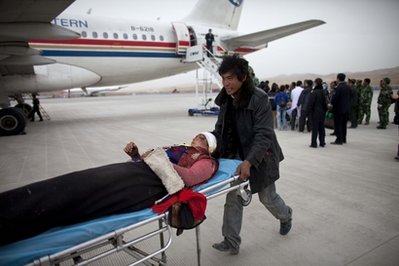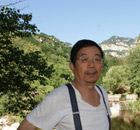Society
Past disasters offer lessons
By Fu Jing and Yan Jie in Yushu, and Hu Yinan and Cao Li in Beijing (China Daily)
Updated: 2010-04-19 07:04
 |
Large Medium Small |
|
 |
|
A man pushes an injured ethnic Tibetan woman from quake-hit Yushu to an ambulance after a plane carrying the injured landed at Xining, where they will get better medical treatment. [Photo/AP]
|
To those watching the relief efforts unfold on live television, images of the search for survivors must bring back vivid memories of the 8-magnitude earthquake that devastated Sichuan province on May 12, 2008, and left nearly 90,000 people dead or missing.
|
||||
Following the lessons of 2008, the China Earthquake Administration adjusted its reaction plans, said Huang Jianfa, director-general of its disaster and emergency management department.
In less than two years, the national rescue team has risen from 200 members to 500, while the professional, rapid-response teams established in 27 provinces have boosted the total number of relief workers nationwide from 3,000 at the time of the Sichuan earthquake to 5,000 today.
Servicemen and women with the People's Liberation Army also now receive regular emergency response training.
"We have equipped our teams with better technologies and facilities, too," said Huang. In Yushu, communication has been improved by using wireless facilities and maritime satellite systems, while remote-controlled aircraft have helped rescuers by sending aerial images of the earthquake-hit regions.
Although lessons from 2008 have helped authorities prepare and respond to the Qinghai tremor, Yushu poses many new challenges to the ongoing relief efforts.
Gyegu, the township hardest hit, is the seat of the Yushu prefecture government and home of 100,000 people. Surrounded by mountains and 4,000 meters above sea level, its narrowest strip is just about three square kilometers between two mighty hills. A 10-meter-wide river runs through this otherwise dry town covered with heavy dust, where the weather changes in a blink of the eye from sunny to snowy or windy.
Yushu county, which includes Gyegu, lies in the heart of the Sanjiangyuan region (its name reflects it is the source of three waterways that spawned Chinese civilization: the Yangtze, Yellow and Lancang rivers). People here live well below the national poverty line and per capita income in 2008 was about 1,900 yuan, barely enough to afford a month's rent in cities like Beijing and Shanghai.
Although its remote setting is seen as a treasure, it is also a major problem for rescue teams.
Options for transporting materials by road are extremely limited.
After the earthquake hit in Yushu, the most immediate aid came from Qamdo in the Tibet autonomous region, which is some 500 km away, and places scattered throughout the neighboring Garze prefecture in Sichuan. But most of the government's relief materials have been stockpiled in Xining, Qinghai's provincial capital, which is 840 km away from Yushu. The drive takes about 12 hours and includes crossing six bumpy, 4,000-meter mountains and two bridges that are reportedly "dangerous and under repair".
Since the earthquake last Wednesday, roads to Yushu have been jammed with cars and trucks ferrying in aid, rescuers, medical workers, reporters and monks. Volunteers were asked to stay away from the disaster zone after many who rushed to the scene developed severe altitude sickness, putting extra pressure on already stretched medical resources, said Wu Tianyi, director of the Qinghai Institute on Plateau Medical Science. However, undeterred, thousands have continued to pour into the region every day.
The only other access to Yushu is by air, but the plateau airport, which is about 30 km from Gyegu and is China's third highest after those in Qamdo and Lhasa in Tibet, only opened last August and cannot operate at night.
Services resume
Despite enormous challenges, Yushu is slowly trying to get back on its feet. The city's two largest temporary settlements at Gyegu stadium and King Gesar Square now offer free rice and porridge for the survivors, and monks are performing tent-to-tent religious services.
|
||||
Although computers at the post office are still not working, basic postal services have resumed. Over the weekend, handwritten letters and packages were set out by the truckload.
Shi Qi, manager of a company that makes temporary houses in Shenzhen, Guangdong province, led a team of staff to Yushu on Wednesday. By Saturday, they had built four sets of makeshift houses, each with five 20-square-meter rooms, in the Gyegu stadium.
These houses will be offered to medical workers at the stadium, said Shi, who aims to set up another 14 sets as soon as possible.
Sources with the local government told China Daily that most of the schools would resume classes from Friday.
Classes had already resumed at makeshift houses of the Yushu Orphans' School starting Saturday afternoon.
(China Daily 04/19/2010 page1)







